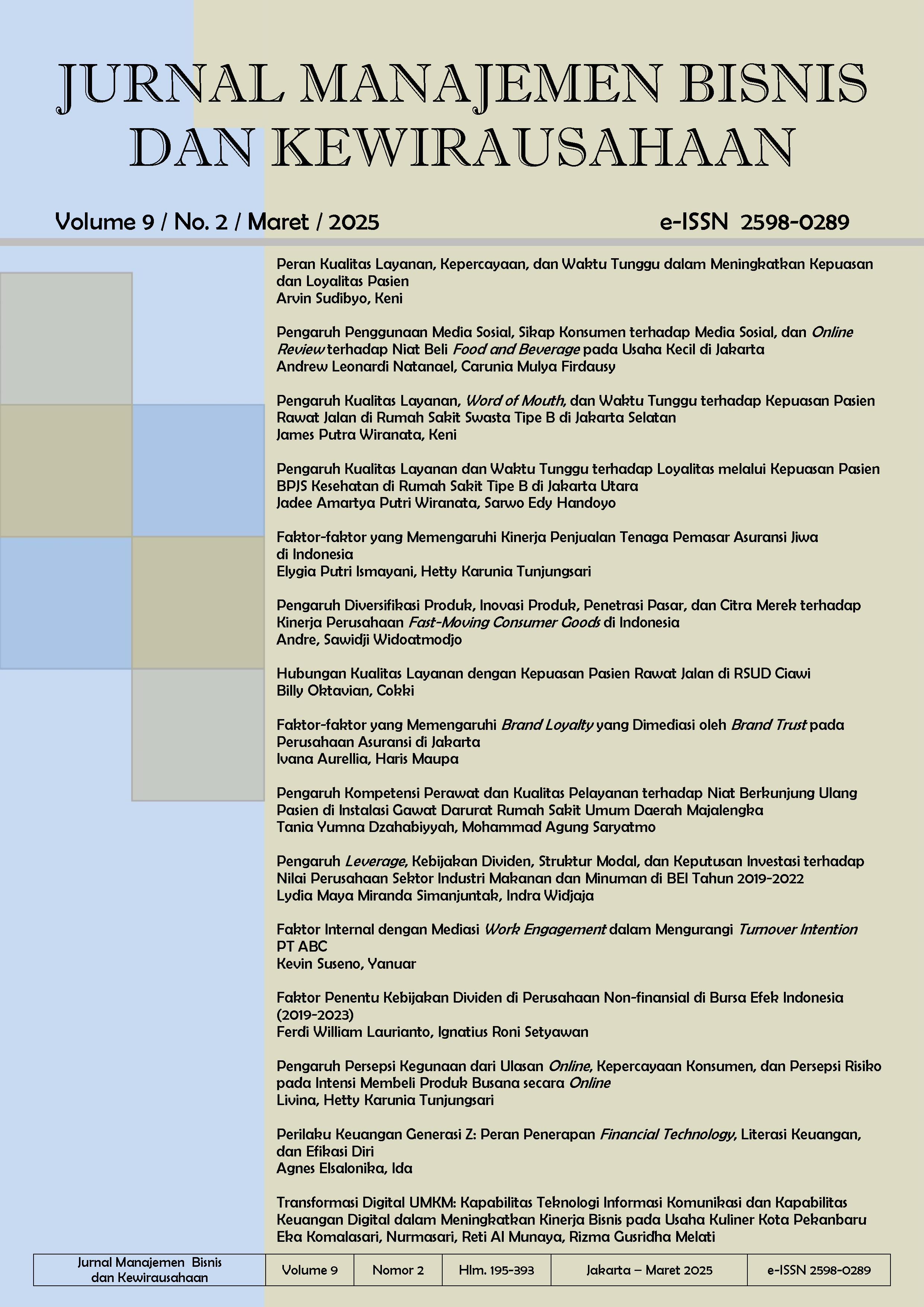Faktor penentu kebijakan dividen di perusahaan non-finansial di Bursa Efek Indonesia (2019-2023)
Isi Artikel Utama
Abstrak
This paper examines the role of dividend policy in corporate financial management and its impact on the relationship between companies and shareholders. Focusing on non-financial companies listed on the Indonesia Stock Exchange that distributed dividends from 2019 to 2023, the study analyzes how factors such as controller ownership, collateralizable assets, liquidity, profitability, and growth influence dividend decisions. Utilizing Agency Theory, the research highlights conflicts that may arise between shareholders and management regarding profit distribution. The analysis examines 754 companies listed during this period. The findings reveal that internal factors significantly shape dividend policies and affect shareholder expectations. This study enhances understanding of how companies balance stable dividends for investors with retained earnings for growth. It offers insights for investors seeking reliable returns and policymakers aiming to understand dividend dynamics in emerging markets, ultimately contributing to effective corporate governance and financial strategy in the region.
Makalah ini mengkaji peran kebijakan dividen dalam manajemen keuangan perusahaan dan dampaknya pada hubungan antara perusahaan dan pemegang saham. Fokus pada perusahaan non-keuangan yang terdaftar di Bursa Efek Indonesia yang membagikan dividen dari 2019 hingga 2023, studi ini menganalisis bagaimana faktor seperti kepemilikan pengendali, aset yang dapat dijaminkan, likuiditas, profitabilitas, dan pertumbuhan mempengaruhi keputusan dividen. Dengan menggunakan Teori Agensi, penelitian ini menyoroti konflik yang mungkin muncul antara pemegang saham dan manajemen terkait distribusi laba. Analisis ini mencakup 754 perusahaan yang terdaftar selama periode tersebut. Temuan menunjukkan bahwa faktor internal secara signifikan membentuk kebijakan dividen dan mempengaruhi ekspektasi pemegang saham. Studi ini memperdalam pemahaman tentang bagaimana perusahaan menyeimbangkan dividen yang stabil untuk investor dengan laba ditahan untuk pertumbuhan. Ini menawarkan wawasan bagi investor yang mencari pengembalian yang dapat diandalkan dan pembuat kebijakan yang ingin memahami dinamika dividen di pasar berkembang, serta berkontribusi pada tata kelola perusahaan dan strategi keuangan yang efektif di kawasan tersebut.
Rincian Artikel

Artikel ini berlisensiCreative Commons Attribution-NonCommercial-ShareAlike 4.0 International License.
This work is licensed under a Jurnal Manajemen Bisnis dan Kewirausahaan Creative Commons Attribution-ShareAlike 4.0 International License.
Referensi
Agyemang, O. S., & Castellini, M. (2015). Corporate governance in an emergent economy: A case of Ghana. Corporate Governance, 15(1), 52–84. https://doi.org/10.1108/CG-04-2013-0051
Amidu, M., & Abor, J. (2006). Determinants of dividend payout ratios in Ghana. The Journal of Risk Finance, 7(2), 136–145. https://doi.org/10.1108/15265940610648580
Brigham, E. F., & Houston, J. F. (2009). Fundamentals of financial management (12. ed). South-Western Cengage Learning.
Claessens, S., Djankov, S., & Lang, L. H. P. (1999). The separation of ownership and control in East Asian corporations. Journal of Financial Economics, 58(1-2), 81-112. https://doi.org/10.1016/S0304-405X(00)00067-2
Eisenhardt, K. M. (1989). Agency theory: An assessment and review. Academy of Management Review, 14(1), 57–74.
Easterbrook, F. H. (1984). Two agency cost explanations of dividends. The American Economic Review, 74(4), 650-659.
Faccio, M., Lang, L. H. P., & Young, L. (2001). Dividends and Expropriation. American Economic Review, 91(1), 54–78. https://doi.org/10.1257/aer.91.1.54
Godfrey, J., Hodgson, A., Tarca, A., Hamilton, J., & Holmes, S. (Eds.). (2010). Accounting theory (7. ed). Wiley.
Harada, K., & Nguyen, P. (2011). Ownership concentration and dividend policy in Japan. Managerial Finance, 37(4), 362–379. https://doi.org/10.1108/03074351111115313
Jensen, C., & Meckling, H. (1976). Theory of the firm: Managerial behavior, agency costs and ownership structure. Journal of Financial Economics, 3(4), 305-360.
Kent Baker, H., & Powell, G. E. (2012). Dividend policy in Indonesia: Survey evidence from executives. Journal of Asia Business Studies, 6(1), 79–92. https://doi.org/10.1108/15587891211191399
Laim, W., Nangoy, S. C., & Murni, S. (2015). Analisis faktor-faktor yang mempengaruhi dividend payout ratio pada perusahaan yang terdaftar di indeks LQ-45 Bursa Efek Indonesia. Jurnal EMBA, 3(1), 1129-1140.
Mauris, F. I., & Rizal, N. A. (2021). The Effect of Collaterallizable Assets, Growth in Net Assets, Liquidity, Leverage and Profitability on Dividend Policy (Case Studies on Non-Financial Services Sector Companies Listed on the Indonesia Stock Exchange for the 2016-2019 Period). Budapest International Research and Critics Institute (BIRCI-Journal): Humanities and Social Sciences, 4(1), 937–950. https://doi.org/10.33258/birci.v4i1.1695
PATTIRUHU, J. R., & PAAIS, M. (2020). Effect of Liquidity, Profitability, Leverage, and Firm Size on Dividend Policy. The Journal of Asian Finance, Economics and Business, 7(10), 35–42. https://doi.org/10.13106/JAFEB.2020.VOL7.NO10.035
Pruitt, S. W., & Gitman, L. J. (1991). The Interactions between the Investment, Financing, and Dividend Decisions of Major U.S. Firms. The Financial Review, 26(3), 409–430. https://doi.org/10.1111/j.1540-6288.1991.tb00388.x
Pujiastuti, T. (2008). Agency cost terhadap kebijakan dividen pada perusahaan manufaktur dan jasa yang go public di Indonesia. Jurnal Keuangan dan Perbankan, 12(2), 183–197.
Rozeff, M. S. (1982). Growth, beta, and agency costs as determinants of dividend payout ratios. The Journal of Financial Research, 5(3), 249-259. https://doi.org/10.1111/j.1475-6803.1982.tb00299.x
Setiawan, D., & Kee Phua, L. (2013). Corporate governance and dividend policy in Indonesia. Business Strategy Series, 14(5/6), 135–143. https://doi.org/10.1108/BSS-01-2013-0003
Sharma, R. K., & Bakshi, A. (2019). An evident prescience of determinants of dividend policy of Indian real estate companies: An empirical analysis using co-integration regression and generalised method of moments. Journal of Financial Management of Property and Construction, 24(3), 358–384. https://doi.org/10.1108/JFMPC-02-2019-0012
Simbolon, K., & Sampurno, D. (2019). Analisis pengaruh firm size, DER, asset growth, ROE, EPS, quick ratio, dan past dividend terhadap dividend payout ratio (Studi pada perusahaan manufaktur yang terdaftar di BEI tahun 2011-2015). Jurnal Manajemen, 6(3), 1-13.
Suharli, M. (2007). Pengaruh profitability dan investment opportunity set terhadap kebijakan dividen tunai dengan likuiditas sebagai variabel penguat. Jurnal Akuntansi dan Keuangan, 9(1), 9-17.
Tran, Q. T. (2019). Creditors and dividend policy: Reputation building versus debt covenant. European Research on Management and Business Economics, 25(3), 114–121. https://doi.org/10.1016/j.iedeen.2019.06.001
Weston, F. J., & Thomas, E. C. (1992). Manajemen Keuangan (Edisi ke-8). Penerbit Erlangga.
Wahjudi, E. (2019). Factors affecting dividend policy in manufacturing companies in Indonesia Stock Exchange. Journal of Management Development, 39(1), 4–17. https://doi.org/10.1108/JMD-07-2018-0211


